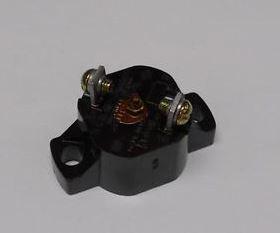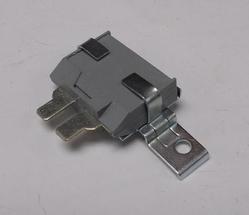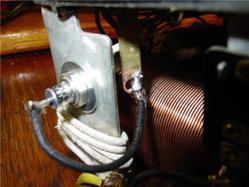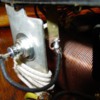Bob, well your on your way to learning some more. I don't know that is the breaker you followed the wire back to. No camera? It is usually kind of buried, but I have seen it moved. A new one may not look anything like this, but will have to be retrofitted in its place. Which isn't very hard there is plenty of room. It will perform in pretty much the same way as the old did.
A fuse used externally as mentioned, it is an amperage test, at the cost of a few fuses. A small variety of extras 10a,6a,3a(aprox) would be ideal. Its a little cheaper test option than buying an amp reader, or paying for replacing a breaker we "think"(so far) is bad.(but that is under 15$ and you may wish to learn to solder, not hard, the last guy likely had too cool of an iron from the sounds of it). And a fuse is always usable elsewhere, never a waste. Everything else about fuses is pretty much a suggestion as to a good way to add a layout safety feature at this point. Find a definite answer to the issue first.
Cooked insulation isn't a good thing either, but possible if you are pulling amps hard all the time. Some of the wires involved in this circuit are special "resistance wires" usually white insulation on them. They have a set ohm value per inch and match the circuit with a specified length, and run hot during shorts. Is that your semi-cooked wiring maybe? On a VW, that heated wire can be found encircled around a ZW breaker so it trips sooner(they ran out of VW breakers on production.) I bet messing with that wiring length is the most common mistake by a non train, but otherwise electrically qualified repairman.
FYI- There are early ZWs with slightly less power too, ZW-R on the bottom base plate is the bigger one. But, I grew up double, and triple heading PW FM Trainmasters hauling 20+, and ABA all powered War bonnets pulling a dozen lit passenger cars, left yard lights on the little left lever, right town lights on the little right lever, all at the same time, while visiting Gramps. Something is amiss, run the lights on that 1033 for a bit if you still have it and "have to run". Guessing at current draw isn't enough anymore. Id have to run lights + 4, overloaded locos, and floor them all from a dead stop to pull a full 10amp trip on my KW, or prewar Z. (+8 lighted switches, 14 scenery bulbs, & lit cabooses) I fished these photos off the net.
Old Breaker New breaker


FYI-This is a modern whistle diode, If you have a big silver/copper "washer", that is the original whistle rectifier disk.










